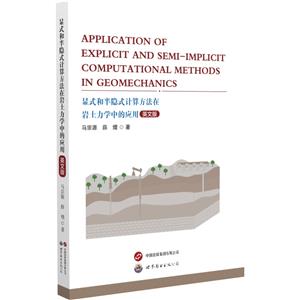1 Introduction
1.1 Explicit numerical method
1.2 Explicit finite different method
1.2.1 Basic algorithm
1.2.2 Governing equation
1.2.3 Constitutive equation
1.3 Explicit finite element method
1.4 Strength theory of geomaterials
2 Application of the Explicit Numerical Method in Slope Stability
2.1 Application of EFDM to Slope Static Stability
2.1.1 Associative and non-associative flow rule
2.1.2 Strength parameter and slope geometry
2.2 Application of EFDM to slope seepage flow stability
2.2.1 Theory of saturated seepage flow
2.2.2 Slope stability due to saturated seepage flow
2.2.3 Slope stability due to unsaturated seepage flow
2.2.4 3D analysis of high slope stability due to saturated seepage flow
2.2.5 Application of EFDM to metro station pit dewatering
2.3 Application of EFEM to dynamic stability problem of slope
2.3.1 Seismic stability of slope
2.3.2 Seismic stability of earth-filled dam slope
2.3.3 Slope instability induced by underground mining
2.4 Earthquake-induced landslide
2.4.1 Two-dimensional analysis
2.5 Summary
3 Application of the Explicit Numerical Method in Foundation Problems
3.1 Application of EFDM to bearing capacity of footing
3.1.1 General problems of bearing capacity of footing
3.1.2 Bearing capacity of strip footing considering influence of O2
3.1.3 Bearing capacity of soft rock beneath footing
3.2 Application of DEM in foundation treatment
3.2.1 Dynamic compaction of gravel soil ground
3.2.2 Dynamic compaction on bridge side embankment
3.3 Summary
4 Application of the Explicit Numerical Method in Rock Dynamics
4.1 Theory of rock dynamics
4.2 Deeply buried tunnel with underground impact Dressure
4.3 Deeply buried rock stratum perforated by a rigid projectjle
4.4 Summary
5 Thermal-Mechanical Analysis of Concrete Structure
5.1 Theory of concrete thermal-mechanical Analysis
5.2 Thermal—mechanical parameters of concrete
5.3 Thermal parameters of concrete
5.4 Calculation theory of the heat of hydration
5.4.1 Heat of hydration
5.4.2 Adiabatic temperature rise
5.4.3 Adiabatic temperature rise exDeriment
5.5 Thermal—mechanical Analysis 0f Concrete Gravitv Arch Dam
5.6 Thermal—mechanical analysis of concrete structure for metro stations
5.6.1 Engineering background
5.6.2 Calculation and analysis
5.6.3 Results and discussion
5.7 Summary
6 Application of CFD in Debris Flow Disaster
6.1Analysis6.1 Theory and method
6.1.1 Theory for computational fluid dynamics
6.1.2 Rheological properties of non—Newtonian fluids
6.2 Engineering background
6.3 Three.dimensional numerical simulation of debris flow
6.4 Summary
7.1 Theory and method
7.1.1 Description of the mathematical model
7.1.2 Gas flow in coal fractures
7.1.3 Gas diffusion in coal matrix
7.1.4 Mechanical equilibrium equation
7.1.5 Damage evolution equation
7.1.6 Coal permeability and porosity
7.1.7 Characterization of coal heterogeneity
7.1.8 Principles of energy method for coal mass
7.1.9 Numerical implementation
7.2 Examination of the numerical scheme
7.2.1 Numerical verification
7.2.2 Experimental verification
7.2.3 Numerical results and parameter analysis
7.2.4 Permeability and gas pressure evolution around borehole
7.2.5 Effect of sorption—induced swelling/shrinkage
7.2.6 Effect of sorption time and Klinkenberg effect
7.2.7 Effect of buried depth.coal strength and gas pressure
7.2.8 Analysis of energy evolution characteristics of coal mass
7.3 Gas fracturing Theory and Control Equation
7.3.1 Gas fracturing model of coal seams
7.3.2 Methane diffusion equation
7.3.3 Gas equilibrium equation
7.3.4 Evolution equation of coal permeability
7.3.5 Mechanical equilibrium equation
7.3.6 Fracture criterion and damage evolution equation
7.3.7 Post-peak strain-softening model and evolution law of the post-peak permeabilitv
7.4 Experimental verification andnumerical model establishment
7.4.1 Gas fracturing test of coal sample
7.4.2 Establishment of the numerical calculation model
7.4.3 Results Analysis of the Numerical Simulation
7.4.4 Influence of seepage parameters on fracture pressure
7.4.5 Damage evolution of coal under the condition of non-uniform in-situ stress
7.5 Numerical simulation of coal seam gas extraction
7.5.1 Variation characteristics of gas pressure
7.5.2 Effect of initial permeability
7.5.3 Influences of adsorption parameters
7.5.4 Effect of initial in-situ stress
7.6 Conclusion
8 Application of Semi-implicit Method in Multifield Coupling Analysis of Geothermal Exploitation
8.1 Equations of the coupled model
8.1.1 Gas diffusion process
8.1.2 Mechanical equilibrium equation
8.1.3 Mass conservation equation of gas and water
8.1.4 Evolutionary characteristics of coal permeability
8.1.5 Thermal equilibrium evolution equation
8.2 Model calculation and analysis
8.2.1 Geometric model
8.2.2 Comparison of previous models
8.2.3 Characteristics analysis of gas drainage and groundwater loss
8.2.4 Effect of initial heat injection temperature
8.2.5 Influence of the diffusion attenuation coefficient
8.2.6 Effect of initial water saturation
8.2.7 Influence of Langmuir adsorption parameters
8.3 Conclusions















